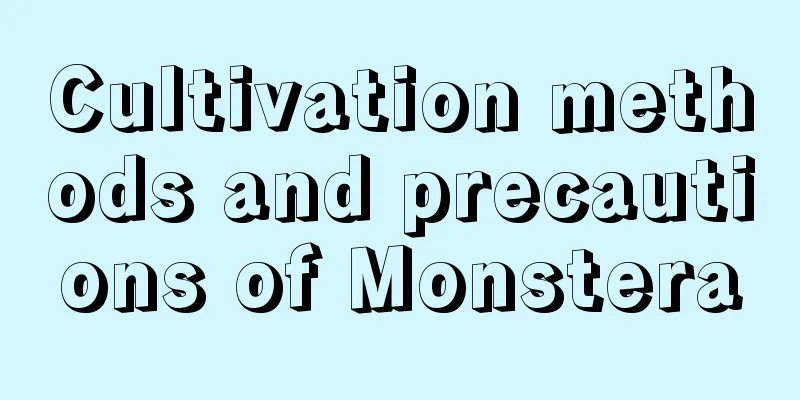Cultivation methods and precautions of Monstera

1. Using soil and changing potsMonstera can take root by cuttings. When transplanting into pots, you can use fertile pond mud or black mountain mud. Monstera grows quickly and needs to be repotted once a year to provide the plant with ample space for growth. Repotting is done between March and April every year. When repotting, remove some of the old soil and dead roots and replace with a larger pot. Put some hoof fragments, broken bones, etc. at the bottom of the pot as base fertilizer, and fill it with a mixture of 1/3 leaf mold, garden soil, and sandy soil. 2. Light and TemperatureMonstera should avoid direct sunlight. In midsummer, the plant should be placed indoors or under a shade shed, not on a balcony where the sunlight is too strong, otherwise, it will easily cause withered leaves and affect its ornamental value. Monstera is not cold-resistant. When the temperature drops to 6℃ in winter, it should be moved indoors to keep warm. The indoor temperature should be controlled between 15~20℃, and the plant can safely overwinter. 3. WaterMonstera likes a humid environment and needs sufficient water and a certain air humidity during its growth period. Daily watering can be done once a day, once in the morning and once in the evening in summer. When the weather is dry, you need to sprinkle water on the leaves and the surrounding environment to ensure fresh and moist air and bright leaves. In winter, water the plants every 3 to 4 days and spray the leaves with water every 7 to 10 days, mainly to clean the leaves, keep the plants evergreen and fresh, and improve their ornamental value. 4. FertilizationMonstera is a fertilizer-loving flower. From April to September, it should be fertilized once every 15 days. Use diluted cake fertilizer water, or fermented animal and plant feces. Only with sufficient nutrients can the leaves be lush green. 5. Notes(1) Likes warmth and dislikes severe cold. Monstera is native to the tropical rain forests of Mexico. It prefers a warm environment and avoids freezing and cold weather. It will not be damaged by frost if the temperature is above 5℃, and it grows well if the temperature is above 12℃. (2) It likes shade and avoids strong light. Monstera has strong shade tolerance. In a semi-shady environment, it grows rapidly and vigorously, has well-developed aerial roots, large leaves, and bright dark green color. (3) It likes moisture and dislikes waterlogging. Monstera likes to grow in a humid ecological environment. There is a lot of rain in the south. If waterlogging lasts too long, the roots, stems and leaves will rot. (4) It prefers fertile soil and dislikes lean soil. Monstera likes fertile soil, especially fertile sandy loam. Although it can grow on lean red-yellow soil, its growth will be weaker, the tree posture will be deformed, the leaves will become smaller, and the leaf color will become lighter, affecting the ornamental effect. (5) It prefers soil fertilizer and dislikes chemical fertilizer. Monstera is often fertilized with organic fertilizers, such as cake fertilizer, artificial organic fertilizer, livestock and poultry manure, and soil fertilizer. The tree is strong, its leaves are as big as plates, the leaves are thick, the leaf color is dark green and shiny, and the tortoise shell pattern is especially clearer. (6) Prune promptly. For newly planted plants, it is necessary to promptly set up supports so that they can grow in the prescribed shape. At the same time, they should be pruned in time to ensure the beauty of the plant shape. (7) Prevent and control diseases and insect pests. Closely monitor and actively prevent diseases and insect pests, and eliminate them in time once they occur. |
<<: What are the common varieties of bougainvillea
>>: The cultivation methods and precautions of bougainvillea
Recommend
How to prune peach during its growing period
Basic knowledge of pruning peach during the growi...
How to fertilize trumpet creeper in spring, which month is better to fertilize
1. How to fertilize trumpet creeper in spring Spr...
How to repot flowers bought online (transplantation methods for newly bought potted plants)
Generally, when we buy flowers online or at the f...
Can the seeds of purple bamboo plum be planted?
Can the seeds of purple bamboo plum be planted? T...
Do flowers attract mosquitoes? Add some of this and mosquitoes will run away when they smell it!
Spray some mint water and all the aphids will die...
What is the best season for planting watermelons?
What month is suitable for planting watermelon? W...
How do colorful calla lilies survive the winter? Will they die in winter?
1. Winter maintenance 1. Increase the temperature...
Just a word of watering in winter can keep your flowers alive for 20 years!
How to water the money tree in winter? A word abo...
Why doesn't the Jade Leaf grow leaves?
1. Replace the soil Reason: Although the Jade Pla...
Potted cultivation method of wine bottle orchid
The bottle orchid, also known as the elephant'...
How to care for hydroponic lilies
Lily hydroponic method Before hydroponically grow...
How to plant and germinate pepper seeds
1. Choose the seed First choose the right pepper ...
Does Orange Ice Bougainvillea bloom frequently?
The color of the Orange Ice Bougainvillea is very...
How to plant strawberry seeds, when and how to plant strawberries
1. Planting time The best time to plant strawberr...
What is garden soil and how to improve it for growing flowers?
1. What is soil Garden soil is a common type of s...









